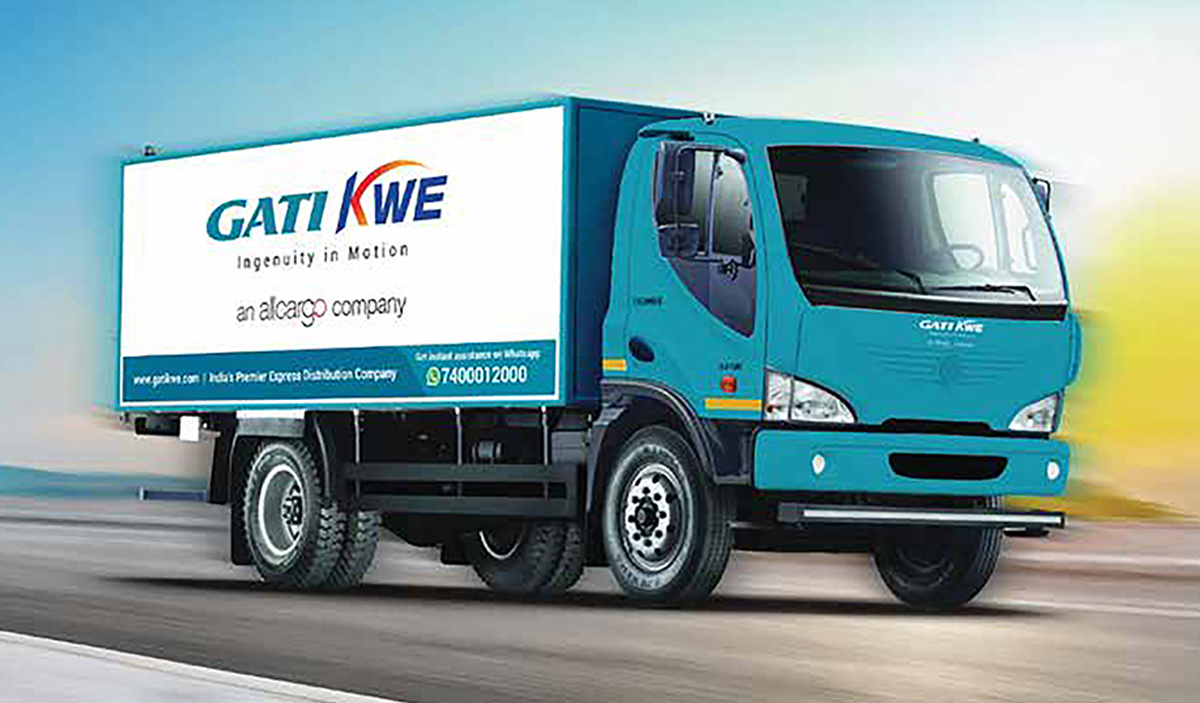The company’s integrated and IT-backed multi-modal network allows it to offer end-to-end supply chain solutions specific to varied business requirements. Meanwhile, the strategic collaboration with Allcargo Logistics enables Gati to leverage the strengths of the former’s global network operating in 180 countries and enhance its products and services portfolio

Incorporated in 1989 as an ‘express distribution’ service provider, Gati Limited has evolved to provide multiple services and solutions in logistics and distribution and emerged as a market leader in varied segments. With a strong presence in the Asia Pacific region and SAARC countries along with an extensive network across India, Gati offers services to 19,800 pin codes, covering 735 out of 739 districts in India and operating on more than 1,900+ scheduled routes. Its integrated multi-modal transportation network comprising air and road helps to ensure timely deliveries across the length and breadth of the country.
Gati’s pan-India warehousing facilities also play a crucial role in offering customised supply chain solutions to customers across various verticals. Its comprehensive portfolio also includes transportation solutions, e-commerce and air freight. Allcargo Logistics is now the promoter and the single largest shareholder of Gati with 47% ownership, followed by KWE with about 3.5% shares in the company. Gati-Kintetsu Express Private Limited (Gati-KWE) is a joint venture between Gati and Kintetsu World Express where the latter holds 30% stake and Gati holds the remaining 70%.
Gati’s integrated and IT-backed multi-modal network allows it to offer end-to-end supply chain solutions specific to varied business requirements. The strategic collaboration with Allcargo Logistics enables Gati to leverage the strengths of the former’s global network operating in 180 countries and enhance its products and services portfolio. The key business verticals of Gati include express distribution, e-commerce, air freight, supply chain management and exclusive B2C services like Laabh, Bike Express, Student Express, and others. Its services and solutions have been designed to be flexible and scalable so as to meet the needs of different businesses across various sizes, locations and industry sectors.
What sets Gati apart are end-to-end solutions built over 30 years of experience and the expertise of a dedicated team of professionals spread across the country. With its focus on ensuring customer-centricity and adopting digital technology, Gati endeavours to always offer safe and timely deliveries that exceed expectations. The organisation has always adhered to the highest environmental, social and corporate governance standards and continues to direct efforts to enhance its people, technology, business processes and operations on a regular basis.
FY21 Financial Performance
In FY21, at a standalone level, Gati recorded revenue of Rs 27,445 lakhs and profit after tax (PAT) of Rs (17,632) lakhs as against a revenue of Rs 42,514 lakhs and PAT of Rs (5,782) lakhs in the previous year. During FY21, at a consolidated level, Gati achieved revenue of Rs 131,424 lakhs and PAT of Rs (24,593) lakhs as against revenue of Rs 171,167 lakhs and PAT of Rs (8,427) lakhs respectively in the previous year.
Business Overview
For Gati, both surface and air express show great potential. Due to reasons of practicality, surface express may be preferred to air express in many instances. Cost is possibly the most significant reason for this – delivery by road would cost a fraction of what air freight would cost. The greater load-bearing capacity of trucks comes in at a close second. Furthermore, with the government’s thrust on investing in developing extensive roadways, the time taken for surface express could be far lesser as compared to the present. Moreover, India’s wide network of roads connecting different geographies is a better match for the penetrative reach that is necessary for the rising e-commerce businesses.

However, when it comes to critical cargo and time-sensitive transportation, especially for pharmaceuticals and essential goods as well as electronic and automotive supply chain elements, the need for reliable air freight solutions is likely to be higher. It would work well for organised logistics market leaders like Gati to focus on developing customised air express services catering to the specific needs of diverse industry sectors. The revamp in Gati’s air freight business vertical with the launch of Gati Air, strengthened by connections to all of India’s commercial airports and partnerships with India’s leading domestic airlines, augurs well for the company as well as its customers who can now rely on Gati for a combination of air and surface express to deliver time-urgent cargo to all parts of the country.
Catalysts for Growth
There are several triggers that will boost growth for Gati, which include:
1. Government’s Focus on Infrastructure
With a focus on building the country’s transport infrastructure through projects such as the creation of highways, freight corridors, logistics parks near ports, and utilising railways for logistics purposes, the logistics sector stands to gain. The government’s plan to reduce logistics overheads in the country is being executed through a series of infrastructure projects and the optimisation of existing resources. These will significantly enable companies like Gati whose forte is express distribution to ride on this infrastructure wave and keep improving its offerings while moving forward in its quest for seamless, end-to-end logistics.
2. Amendments to Transport Regulations
In June 2020, in the 6th amendment to the Central Motor Vehicles Act, the Ministry of Transport gave permission to increase the height and length of a number of vehicle segments in order to increase the load capacity of commercial goods’ carriers – up to 4.52 metres high for ISO Series 1 cargo container and up to 4 m for other trucks. Due to this move, the dimensions of motor vehicles can be aligned to international standards and this is likely to improve the logistics efficiency of the country. Further, individuals who wish to get licenses for driving e-karts and e-rickshaws can now undergo training for a period of minimum 10 days and obtain a certificate from state government-authorised institutions. This has the potential to reduce environmental impact and make logistics more sustainable.
3. Technology Powering Logistics
With the increasing adoption of technologies such as artificial intelligence, blockchain solutions and machine learning, India is slowly but steadily seeing the coming of Logistics 4.0. The adoption of technology in both arms of the Indian logistics sector i.e. transportation and warehousing is driving efficiencies, delivering speed, increasing visibility and enhancing ease of operations as well as ease of doing business. The customer-driven demand for ease and comfort as also swift, convenient deliveries is accelerating the digital transformation of the logistics sector. The lower turnaround time (TAT) and zero margin for errors will also help to lower costs – an outcome the government is keen on arriving at to enhance profitability of the sector.
4. E-Commerce Driving Demand for 3PL and 4PL Services
The logistics sector is one of the enablers of e-commerce and the resultant retail boom that has taken place in the country. With the pandemic mandating physical safety, numerous businesses are trying to fill the gap created in the physical space. These online businesses are increasingly looking to outsource their logistics requirements to experienced, safe and reliable players, enabling them to focus on growing their business and their capacity. Gati, with its three decades of experience and multi-level presence in the supply chain, is in a perfect position to leverage this and fuel India’s growth story.

5. Clarion Call for Self-Reliant India
A key response to ensuring recovery of India’s economy in the aftermath of the pandemic has been to encourage entrepreneurial ambitions and a ‘vocal for local’ approach to support small businesses in various sectors. This move aiming to increase manufacturing and distribution of goods and services within the country is also creating unique opportunities for logistics players who form a critical element of this domestic supply chain.
Core Competencies
Some of the company’s unique competencies include:
• Wide Domestic and International Network: One of Gati’s central strengths is its extensive reach across all parts of the country – 99% of the government-approved pin codes. Achieving this unparalleled reach has required effort and commitment to build, nurture and continue adding to its network of associates and channel partners – thereby giving Gati the geographic expanse that few other service providers can match. Further, as an Allcargo Logistics’ company, Gati is now in a position to help its customers access a global network operating in 180 countries.
• Diversified Solutions: Gati’s multi-level supply chain offerings such as express distribution, air freight, e-commerce, supply chain management and special services make it a one-stop solution for all kinds of logistics requirements for a variety of industry sectors.
• World-Class Infrastructure and Facilities: Gati’s warehouse capacity of 4.1 million sq. feet, its best-in-class warehouse management system along with strategically located e-fulfilment centres offer much-needed customised storage solutions to businesses. These pan-India warehousing facilities in conjunction with technology-enabled multi-modal network transportation allow for customised supply chain solutions across locations and industries. With upcoming surface transhipments centres (STCs) and air transit centres (ATCs) at strategic locations Gati is in a position to further optimise on cost and turnaround times.
• Advanced Technology: Technology is used to deliver ease to customers. In addition to greater visibility of cargo and data sharing, technology is also leveraged to lower cost. To achieve this, technology is used for data sharing between operations, customers and vendors to facilitate warehouse management, route optimisation, freight consolidation, back office functions and other services. Instant assistance over a social media channel through Gati Genie, an upcoming customer portal, along with a website, mobile application and an organisation-wide enterprise resource planning software – GEMS comprise key elements of Gati’s technology developments.
• Collaborative Partnership: Gati’s partnership with Kintetsu World Express is accelerating Gati’s transformation, enabling it to grow and expand in scope. The quality improvement techniques of Kaizen, 5S and LEAN that KWE implements play a key role in augmenting Gati’s service quality. Gati has been implementing structural changes on the basis of advanced analytical tools to optimise its routes and distribution network.
• The Allcargo Advantage: As an Allcargo Logistics’ company, Gati is bolstered to offer its customers expert services and solutions in NVOCC, CFS-ICD, project logistics, contract logistics and logistics parks. Additionally, through its transformation project, Project Avvashya, and adoption of the Avvashya vision, mission and values, Gati now has an effective roadmap to leap to the next level of business growth and success. It also stands to benefit from Allcargo Logistics’ expertise in professional leadership, efficient management capabilities, adherence to highest standards of corporate governance and employee-friendly policies.
Project Avvashya: Redefining Possibilities
Since becoming part of the larger Allcargo Logistics’ family, Gati has embarked on a journey of transformation with Project Avvashya. As the name suggests, this intensive transformation initiative is redefining possibilities for Gati. Implemented in partnership with transformation specialists Alvarez and Marsal, the project is aimed at making Gati digitally savvy, future-ready, and ahead in its league. Business operations and teams are being re-structured to accelerate sales, reduce inefficiencies and optimise operations. Talent has been brought in from within and outside the industry to steer Gati in the direction of its aspirations. The positive impact of this project has been visible in the encouraging business performance across Gati’s different business verticals, which has also motivated Gati to set bigger, more ambitious targets for the coming year.